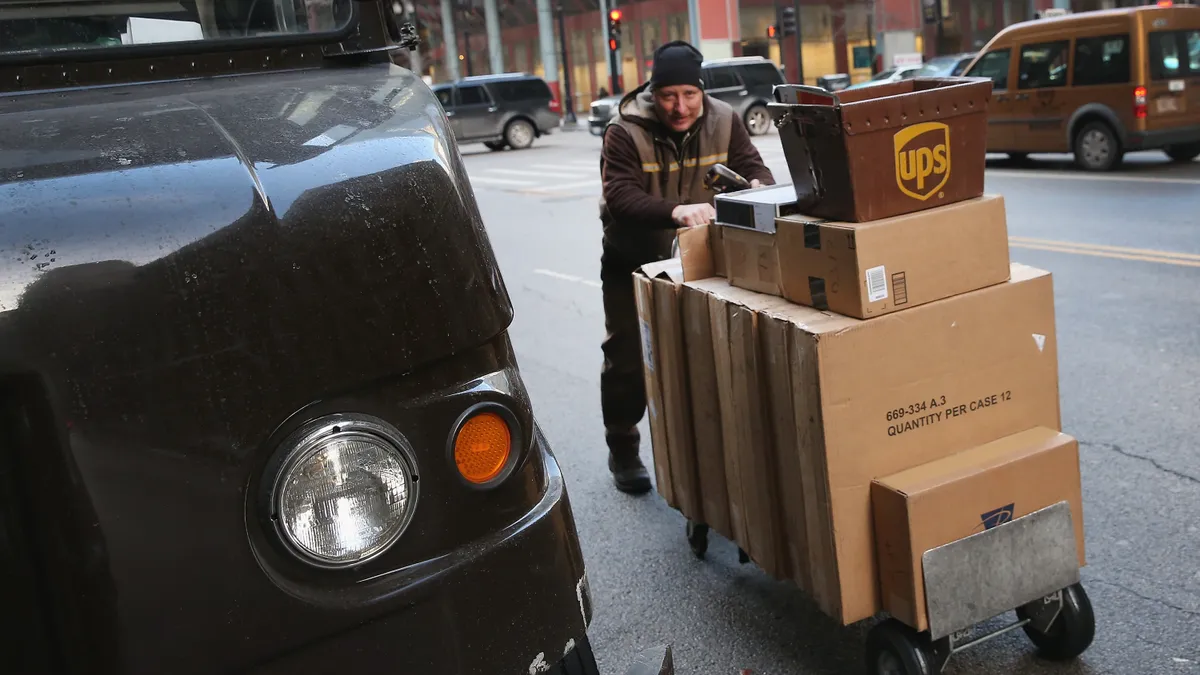It's a tough time to be a heavy package shipper.
With rate and surcharge increases looming from both FedEx and UPS, businesses that need bulkier products delivered are going to feel the sting, parcel pricing experts told Supply Chain Dive. This includes furniture, home goods and sports equipment shippers, per analysis from Reveel, a parcel spend management platform provider.
The delivery rivals have defended their pricing changes through the years, saying the increases are necessary to maintain reliable services while strengthening their networks for the future. The companies also have further incentive to hike bulky delivery pricing more aggressively than other shipment types, according to experts.
For one, there are fewer alternative carriers willing to handle bulky deliveries compared to heightened competition in the lightweight shipping space. This compounds the challenge of shipping heavier and oversized shipments, which aren't as easy to move efficiently through a carrier's network as smaller parcels.
"The last few years, especially after 2020 and COVID-19 and all of that, there's been a push by both FedEx and UPS to move out large and bulkier packages," said Jack McCrum, director of optimization and analytics at Reveel. "And so what we're seeing this year is really a doubling down on those increases."
Both FedEx and UPS have effectively doubled delivery surcharges for packages considered large or oversized in the past five years, according to Reveel. That pricing pressure will continue under the carriers' upcoming rate increases, which include double-digit price hikes for a range of bulky package surcharges. UPS' will take effect Dec. 23, while FedEx's will begin Jan. 6, 2025.
FedEx, UPS match large package delivery increases
Those higher fees will outpace increases to other surcharges that FedEx and UPS will levy, such as those for address corrections, shipments to remote areas and home deliveries, all of which will see single-digit percentage increases, per Reveel.
"If that is not a clear indication from the carrier side to take these undesirable packages out of their network, I don't know what would be," said Mingshu Bates, chief analytics officer at AFS Logistics.
UPS rolls out bulky surcharge tweaks
While FedEx and UPS follow each other closely on larger package pricing, the two are deviating slightly on how they calculate and charge for certain fees. In October, UPS instituted a minimum billable weight of 40 pounds for packages requiring additional handling due to their dimensions.
Mark Kolde, VP of logistics engineering at logistics software provider Sifted, said this change particularly hurts businesses shipping large but relatively lightweight goods like molding or trimming. Under the new UPS rule, such businesses will be charged as if they were shipping heavier packages. Customers with goods that are already heavy, like mattresses, likely aren’t sweating the changes as much, he added.
FedEx hasn't yet announced a similar change. The carrier likely wants to find out if UPS ends up losing some business as a result, according to Adi Karamcheti, a senior consultant for professional services at Shipware. It's also possible that FedEx is more willing to accept bulkier parcels, he added.
"FedEx is typically a little better, a little more willing to handle bigger stuff, the network's a little newer, and so maybe they want it," Karamcheti said.

Other experts expect FedEx will eventually match UPS on the surcharge adjustment, given the rivals' habit of chasing each other on pricing. However, FedEx's response may not occur for at least a few months, according to AFS Logistics' Bates. While a surcharge's price can be adjusted quickly, more complex changes like the one UPS rolled out are harder to implement, she added.
UPS is planning further changes related to bulky delivery pricing early next year, when it tweaks the measurements used to determine if additional surcharges apply, according to an announcement on its website. Experts say pending further details, the impact of the adjustments won't be clear until they are implemented.
Mitigating cost pressures
Although FedEx and UPS are willing to offer higher discounts in a soft demand environment, negotiating against larger package fees can be an uphill battle, Reveel's McCrum said. But shippers can take matters into their own hands by slimming down their packaging sizes.
"Are you sending a lot of packing peanuts? Are you sending a lot of air in your package volumes? Going through the routine and the analysis of evaluating your package dimensions is a really good first step," McCrum said.
McCrum's colleague, Reveel CEO and co-founder Josh Dunham, said shippers should also consider if their oversized packages would be better suited for a non-parcel transportation mode, such as less-than-truckload shipping. That can help avoid particularly hefty fees like UPS' over maximum limits surcharge, which will increase to $1,325 on Dec. 23.
Customers can also consider using more economical shipping services in scenarios in which they would perform similarly, such as with shorter-distance shipments.
"If Ground in Zone 2 is delivering similarly to Air in Zone 2 (which is common), moving to ground might be a smart option," according to a rate increase guide from Cass Information Systems.























